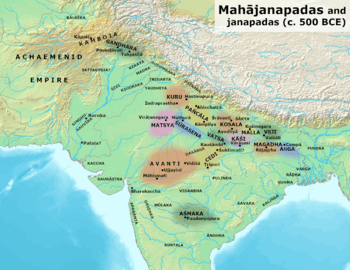Asmaka facts for kids
Quick facts for kids
Kingdom of Aśmaka
|
|
|---|---|
| c. 700 BCE–425 or 345 BCE | |

Asmaka and other Mahajanapadas in the Post Vedic period.
|
|
| Capital | Potali or Podana |
| Common languages | Prakrit Sanskrit |
| Religion | Historical Vedic religion Buddhism Jainism |
| Government | Monarchy |
| Maharaja | |
| Historical era | Iron Age |
|
• Established
|
c. 700 BCE |
|
• Disestablished
|
425 or 345 BCE |
| Today part of | India |
Asmaka (also called Assaka) was an important ancient kingdom in India. It was one of the sixteen "Mahajanapadas," which were large, powerful states that existed long ago. Asmaka was around from about 700 BCE to 425 or 345 BCE. You can find mentions of it in old Buddhist texts and Hindu Puranas.
This kingdom covered parts of what is now Andhra Pradesh, Telangana, and Maharashtra. During the time of Gautama Buddha, many people from Assaka lived near the Godavari River. This river is south of the Vindhya mountains. The capital city of Asmaka was known by different names, like Potali or Podana. Today, this ancient capital is believed to be the city of Bodhan in Telangana.
Where Was Asmaka Located?
Asmaka was situated along the Godāvarī river. It was located between two other ancient regions, Mūlaka and Kaliṅga.
The main city of Asmaka was called Podana, Potali, Paudanyapura, or Potana. This city is now known as Bodhan.
A Look at Asmaka's History
The kingdom of Asmaka was already established a very long time ago. It existed when the ancient Hindu texts called the Brāhmaṇas were being written. One of Asmaka's kings, named Brahmadatta, was mentioned in an old Buddhist story. He lived at the same time as other famous kings, like Reṇu of Videha and Dhataraṭṭha of Kāsī.
During the period of the Mahajanapadas, Asmaka grew stronger. It took over a smaller kingdom called Mūlaka, which was to its west. After this, Asmaka became the southern neighbor of the powerful kingdom of Avanti.
An ancient stone inscription, called the Hathigumpha inscription, talks about a king named Kharavela. This inscription, from the 2nd century BCE, mentions Kharavela threatening a city. This city is thought to be "Asika" or "Asikanagara," which some historians believe was the capital of Asmaka. Another important discovery was a clay seal found in a village called Adam in the Nagpur district. This seal mentioned the Asmaka region. The Asmaka kingdom also included the Mulaka area, which is now around Paithan. This place was known as Pratishthana in ancient times.
See also

